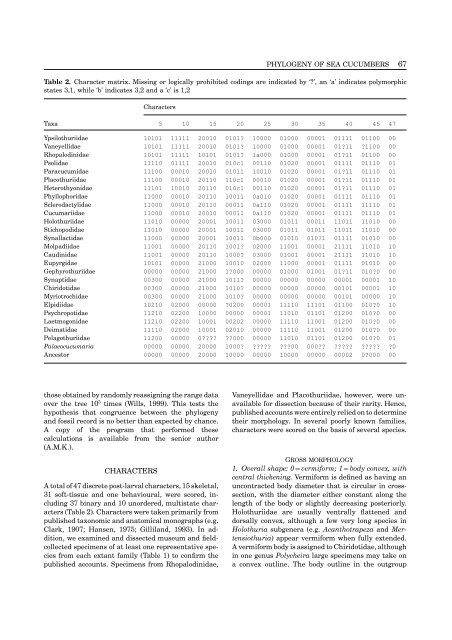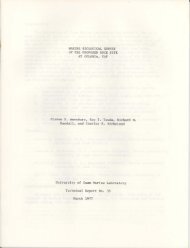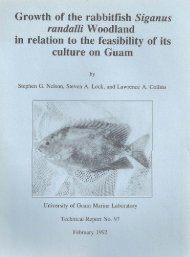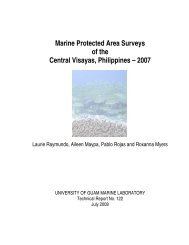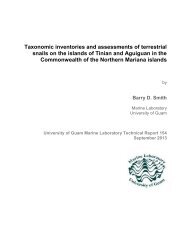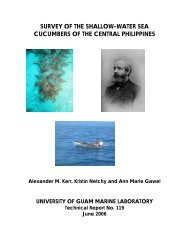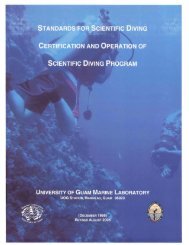Phylogeny of Holothuroidea (Echinodermata) inferred from ...
Phylogeny of Holothuroidea (Echinodermata) inferred from ...
Phylogeny of Holothuroidea (Echinodermata) inferred from ...
Create successful ePaper yourself
Turn your PDF publications into a flip-book with our unique Google optimized e-Paper software.
PHYLOGENY OF SEA CUCUMBERS 67<br />
Table 2. Character matrix. Missing or logically prohibited codings are indicated by ‘’, an ‘a’ indicates polymorphic<br />
states 3,1, while ‘b’ indicates 3,2 and a ‘c’ is 1,2<br />
Characters<br />
Taxa 5 10 15 20 25 30 35 40 45 47<br />
Ypsilothuriidae 10101 11111 20010 0101 10000 01000 00001 01111 01100 00<br />
Vaneyellidae 10101 11111 20010 0101 10000 01000 00001 0111 1100 00<br />
Rhopalodinidae 10101 11111 10101 0101 1a000 01000 00001 0111 01100 00<br />
Psolidae 11110 01111 20010 010c1 00110 01020 00001 01111 01110 01<br />
Paracucumidae 11100 00010 20010 01011 10010 01020 00001 0111 01110 01<br />
Placothuriidae 11100 00010 20110 110c1 00010 01020 00001 0111 01110 01<br />
Heterothyonidae 11101 10010 20110 010c1 00110 01020 00001 0111 01110 01<br />
Phyllophoridae 11000 00010 20110 10011 0a010 01020 00001 01111 01110 01<br />
Sclerodactylidae 11000 00010 20110 00011 0a110 01020 00001 01111 11110 01<br />
Cucumariidae 11000 00010 20010 00011 0a110 01020 00001 01111 01110 01<br />
Holothuriidae 11010 00000 20001 10011 03000 01011 00011 11011 11010 00<br />
Stichopodidae 11010 00000 20001 10011 03000 01011 01011 11011 11010 00<br />
Synallactidae 11000 00000 20001 10011 0b000 01010 0101 01111 01010 00<br />
Molpadiidae 11001 00000 20110 1001 02000 11001 00001 21111 11010 10<br />
Caudinidae 11001 00000 20110 1000 03000 01001 00001 21111 11010 10<br />
Eupyrgidae 10101 00000 21000 10010 02000 11000 00001 01111 01010 00<br />
Gephyrothuriidae 00000 00000 21000 1000 00000 01000 01001 0111 0100 00<br />
Synaptidae 00300 00000 21000 1011 00000 00000 00000 00001 00001 10<br />
Chiridotidae 00300 00000 21000 1010 00000 00000 00000 00101 00001 10<br />
Myriotrochidae 00300 00000 21000 1010 00000 00000 00000 00101 00000 10<br />
Elpidiidae 10210 02000 00000 0200 00001 11110 11101 01100 0100 10<br />
Psychropotidae 11210 02200 10000 00000 00001 11010 01101 01200 0100 00<br />
Laetmogonidae 11210 02200 10001 00202 00000 11110 11001 01200 0100 00<br />
Deimatidae 11110 02000 10001 02010 00000 11110 11001 01200 0100 00<br />
Pelagothuriidae 11200 00000 0 000 00000 11010 01101 01200 0100 01<br />
Palaeocucumaria 00000 00000 20000 1000 00 000 0<br />
Ancestor 00000 00000 20000 10000 00000 10000 00000 00002 0000 00<br />
those obtained by randomly reassigning the range data Vaneyellidae and Placothuriidae, however, were unavailable<br />
over the tree 10 5 times (Wills, 1999). This tests the<br />
for dissection because <strong>of</strong> their rarity. Hence,<br />
hypothesis that congruence between the phylogeny published accounts were entirely relied on to determine<br />
and fossil record is no better than expected by chance. their morphology. In several poorly known families,<br />
A copy <strong>of</strong> the program that performed these characters were scored on the basis <strong>of</strong> several species.<br />
calculations is available <strong>from</strong> the senior author<br />
(A.M.K.).<br />
GROSS MORPHOLOGY<br />
CHARACTERS<br />
1. Overall shape: 0=vermiform; 1=body convex, with<br />
central thickening. Vermiform is defined as having an<br />
A total <strong>of</strong> 47 discrete post-larval characters, 15 skeletal, uncontracted body diameter that is circular in cross-<br />
31 s<strong>of</strong>t-tissue and one behavioural, were scored, in- section, with the diameter either constant along the<br />
cluding 37 binary and 10 unordered, multistate characters<br />
length <strong>of</strong> the body or slightly decreasing posteriorly.<br />
(Table 2). Characters were taken primarily <strong>from</strong> Holothuriidae are usually ventrally flattened and<br />
published taxonomic and anatomical monographs (e.g. dorsally convex, although a few very long species in<br />
Clark, 1907; Hansen, 1975; Gilliland, 1993). In ad- Holothuria subgenera (e.g. Acanthotrapeza and Mertensiothuria)<br />
dition, we examined and dissected museum and fieldcollected<br />
appear vermiform when fully extended.<br />
specimens <strong>of</strong> at least one representative spe- A vermiform body is assigned to Chiridotidae, although<br />
cies <strong>from</strong> each extant family (Table 1) to confirm the in one genus Polycheira large specimens may take on<br />
published accounts. Specimens <strong>from</strong> Rhopalodinidae, a convex outline. The body outline in the outgroup


